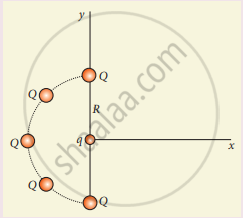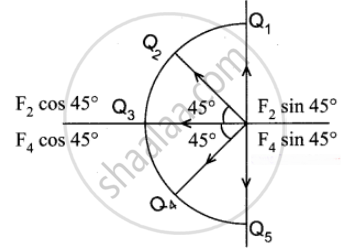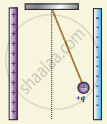Advertisements
Advertisements
Question
Five identical charges Q are placed equidistant on a semicircle as shown in the figure. Another point charge q is kept at the center of the circle of radius R. Calculate the electrostatic force experienced by the charge q.

Solution
Force acting on q due to Q1 and Q5 are opposite direction, so cancel to each other.
Force acting on q due to Q3 is F3 = `1/(4pi epsilon_0) ("qQ"_3)/"R"^2`
Force acting on q due to Q2 and Q4
Resolving in two-component method:
- Vertical Component:
Q2 Sin θ and Q4 Sinθ are equal and opposite direction, so they are cancel to each other. - Horizontal Component:
Q2 Sin θ and Q4 cos θ are equal and same direction, so they can get added.
F24 = F2q + F4q = F2 cos 55° + F4 cos 45°
F24 = `1/(4pi epsilon_0) ("qQ"_3)/"R"^2 cos 45^circ + 1/(4pi epsilon_0) ("qQ"_4)/"R"^2 cos 45^circ`
Resultant net force F
F = F3 + F24 + F15
Q = Q1 = Q2 = Q3 = Q4 = Q5
cos 45° = `1/sqrt2`
F = `"qQ"/(4pi epsilon_0 "R"^2) [1 + 1/sqrt2 + 1/sqrt2]`
`= 1/(4pi epsilon_0) "qQ"/"R"^2 [1 + 2/sqrt2]`
F = `1/(4pi epsilon_0) "qQ"/"R"^2 [1 + sqrt2]`N
Vector form:
`vec"F" = 1/(4pi epsilon_0) "qQ"/"R"^2 (1 + sqrt2) "N"hat"i"`
APPEARS IN
RELATED QUESTIONS
Which charge configuration produces a uniform electric field?
Rank the electrostatic potential energies for the given system of charges in increasing order.

Two points A and B are maintained at a potential of 7 V and -4 V respectively. The work done in moving 50 electrons from A to B is ______.
What is an equipotential surface?
What are the properties of an equipotential surface?
What is meant by electrostatic energy density?
Derive an expression for electrostatic potential energy of the dipole in a uniform electric field.
The total number of electrons in the human body is typically in the order of 1028. Suppose, due to some reason, you and your friend lost 1% of this number of electrons. Calculate the electrostatic force between you and your friend separated at a distance of lm. Compare this with your weight. Assume the mass of each person is 60kg and use point charge approximation.
Suppose a charge +q on Earth’s surface and another +q charge is placed on the surface of the Moon,
- Calculate the value of q required to balance the gravitational attraction between Earth and Moon
- Suppose the distance between the Moon and Earth is halved, would the charge q change?
(Take mE = 5.9 x 1024 kg, mM = 7.348 x 1022 kg)
Draw the free body diagram for the following charges as shown in the following figure.

